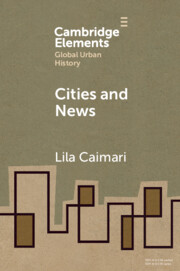Element contents
Cities and News
Published online by Cambridge University Press: 23 December 2021
Summary
- Type
- Element
- Information
- Series: Elements in Global Urban HistoryOnline ISBN: 9781108914666Publisher: Cambridge University PressPrint publication: 10 March 2022
Bibliography
Primary Sources
Secondary Sources
- 7
- Cited by

